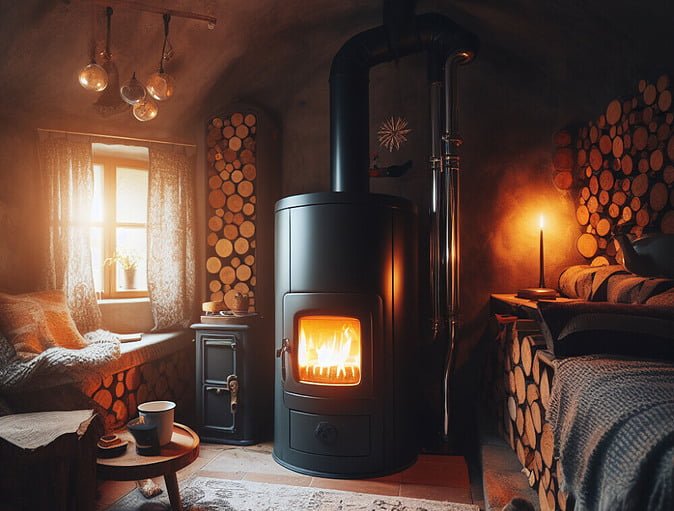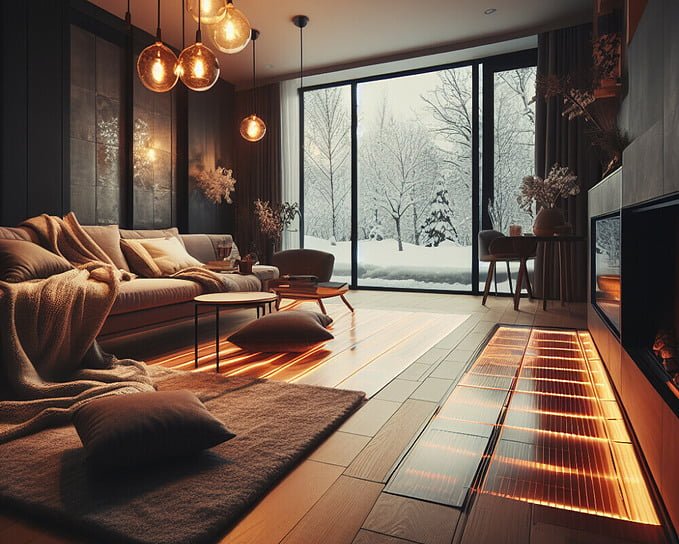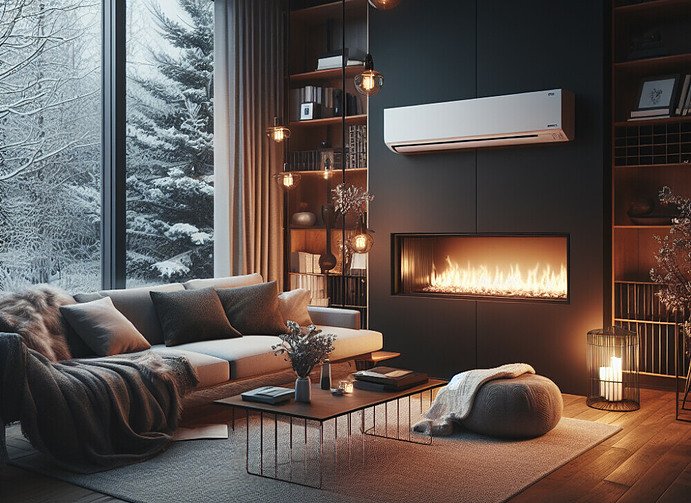Embracing off-grid living for an independent lifestyle involves responsibly ensuring your home stays warm without relying on traditional energy. Off-grid heating solutions are not only about comfort; they also reduce dependency on non-renewable energy, lower costs, and enhance self-sufficiency, contributing to a reduced carbon footprint. Despite challenges like maintaining heat without electricity, extreme climates, and setup costs, practical solutions and innovative approaches can guide you to sustainable warmth. Explore renewable energy options, including solar, geothermal heat pumps, and biomass heating, creating a cosy, eco-friendly home.
Off-Grid Heating: How to Warm Your Off-Grid Home
England, renowned for its picturesque landscapes and charming countryside, bears the brunt of prolonged cold weather for nearly two-thirds of the year. In this climate, approximately 15% of homes lack the convenience of a main gas connection. In response to this unique challenge, this article on off-grid heating solutions provides valuable insights tailored to meet the needs of homes grappling with the absence of traditional energy sources. The focus here is not only on providing warmth during the frosty winter months but also on sustainable and affordable options that cater to year-round comfort.
Winter Comfort: Insulation, Sunlight, and Efficient Heating Strategies for a Cozy Home
Ensuring a well-insulated and draft-free home is crucial in combating winter’s chill. Adequate insulation and sealing drafts prevent heat loss and enhance heating system efficiency, reducing energy bills. Harnessing sunlight is a cost-effective strategy: strategically placing furniture and reflective surfaces near windows captures and retains natural warmth, creating a cosy atmosphere while minimizing reliance on traditional heating methods. Together, insulation and sunlight utilization offer a sustainable approach to staying warm and comfortable during the winter months.
Embracing Affordability and Sustainability
Central to the article’s mission is emphasizing affordability and sustainability. Recognizing that off-grid living often involves a conscious choice to reduce environmental impact, the heating solutions discussed encompass a spectrum of eco-friendly options. From biomass boilers and underfloor heating to the utilization of heating pumps and solar heating, the goal is to not only provide warmth but to do so in a manner that aligns with sustainable practices.
How to Add Off-Grid Heating
Off-grid heating solutions are crucial for homes that lack access to traditional utilities such as mains gas or electricity. Here are various options for off-grid heating:
1. Biomass Boilers

A biomass boiler is a heating system that uses organic materials like wood pellets to produce heat. It’s eco-friendly as the carbon emitted is balanced by the biomass material’s growth. While renewable, it may have higher initial costs and require proper fuel storage and supply.
Pros: Leveraging renewable fuel sources such as wood pellets and logs, biomass boilers offer an eco-friendly alternative. They contribute to a reduced carbon footprint and, over time, prove cost-effective.
Cons: Initial installation costs and the need for space to store fuel may pose challenges.
2. Underfloor Heating

Hydronic (Water-Based) Underfloor Heating: In this system, warm water is circulated through a network of pipes installed beneath the floor. The water is heated using a boiler, heat pump, or other heat sources, and the warmth is then emitted evenly through the floor. Hydronic underfloor heating is known for its efficient and even distribution of heat.
Electric Underfloor Heating: Electric underfloor heating utilizes electric heating cables or mats installed beneath the floor surface. When electricity passes through these elements, they generate heat that warms the floor and radiates upward. Electric underfloor heating systems are often preferred in smaller areas or where retrofitting is more practical.
Key Features of Underfloor Heating
Even Heat Distribution: Underfloor heating provides a more uniform distribution of heat compared to traditional radiators, creating a comfortable and consistent warmth throughout the room.
Energy Efficiency: Because the floor’s large surface area allows for lower operating temperatures, underfloor heating systems can be more energy-efficient than traditional heating methods.
Space Saving: The absence of radiators or other visible heating elements allows for more flexibility in room design and furniture placement.
Reduced Allergens: Without the need for air circulation, underfloor heating systems can reduce the circulation of dust and allergens, promoting a healthier indoor environment.
Silent Operation: Underfloor heating operates quietly, eliminating the noise associated with traditional heating systems.
Versatility: Underfloor heating can be installed under various floor coverings, including tile, stone, wood, laminate, and even carpet (with certain systems).
3. Heating Pumps: Efficient Climate Control Solutions

Air Source Heat Pumps (ASHP)
Pros:
1. Impressive Efficiency: ASHPs have an efficiency range of 300-500%.
2. Year-Round Functionality: ASHPs offer both heating and cooling capabilities.
3. Electric-Powered Adaptability: ASHPs can be powered by electricity, aligning with eco-friendly initiatives.
Cons:
1. Upfront Installation Costs: Initial installation costs may be higher.
2. Electricity Dependency: ASHPs rely on electricity, which can be a drawback in areas with power challenges.
Ground Source Heat Pumps (GSHP)
Pros:
1. High Efficiency: GSHPs provide consistent, high efficiency.
2. Stable Temperature Utilization: GSHPs tap into the Earth’s stable temperature.
3. Environmental Conservation: GSHPs contribute to environmental conservation.
Cons:
1. Higher Initial Costs: GSHPs may involve higher upfront installation costs.
2. Intricate Installation: GSHPs require specialized knowledge and installation procedures.
3. Electricity Dependency: Similar to ASHPs, GSHPs depend on electricity.
Homeowners weigh upfront investment against long-term benefits when choosing between ASHPs and GSHPs, both offering sustainable solutions for efficient heating and cooling.
4. Solar Heating
Pros: Harnessing the power of renewable energy, solar heating systems boast low operational costs and contribute to a reduced carbon footprint.
Cons: Initial installation costs can be a deterrent, and their efficiency is contingent on sunlight availability, making them somewhat weather-dependent.
5. Wood Stoves and Pellet Stoves
Pros: Emitting a cosy ambience, these stoves utilize renewable fuel sources, including wood or wood pellets. They can be a cost-effective heating solution.
Cons: The constant supply of wood may pose a challenge, and heat distribution may not be uniform throughout the space.
6. Propane Heaters
Pros: Portable and efficient, propane heaters are versatile and can be used for both space heating and whole-house heating.
Cons: The need for a propane supply, operational costs, and concerns about sustainability compared to other options.
7. Electric Heating
Pros: Compatible with off-grid renewable energy sources like solar and wind, electric heating is relatively easy to install.
Cons: Operational costs, especially when relying on conventional grid electricity, can be higher.
Pros: Utilizing hot water or steam for distribution, hydronic systems can be powered by various sources, including wood, propane, or solar.
Cons: Installation complexity and potential maintenance requirements may be factors to consider.
8. Heating with Biodiesel
Pros: Offering a cleaner-burning alternative, biodiesel heating is compatible with some existing oil heating systems.
Cons: The availability of biodiesel and potential modifications required for existing systems may pose challenges.
9. Geothermal Heating: Harnessing Earth’s Stability
Geothermal heating uses the Earth’s stable temperature to efficiently warm buildings. A fluid circulates underground, absorbing heat, which is then transferred to the building’s heating system.
Its merits include:
Exceptional Efficiency: Geothermal systems are highly efficient, providing sustainable warmth year-round.
Stable Temperature Utilization: Leveraging the Earth’s stable temperature ensures consistent performance in varied weather conditions.
Reduced Environmental Impact: Geothermal heating is environmentally friendly, minimizing greenhouse gas emissions.
Considerations when opting for geothermal heating:
High Upfront Costs: The installation involves significant upfront investment due to the complexity of the ground loop system.
Intricate Installation: Specialized knowledge is needed for the installation, potentially extending the timeline.
Dependency on Electricity: Geothermal systems rely on electricity, which may be a challenge in areas with power issues.
In summary, off-grid living for sustainable warmth involves balancing eco-friendly practices and cost considerations. From insulation to diverse heating options like biomass boilers and geothermal heating, tailored solutions cater to diverse needs. The investment in sustainable heating signifies a commitment to a harmonious relationship with nature and a self-sufficient lifestyle. In overcoming challenges like extreme climates and setup costs, the practical solutions outlined here guide individuals toward a warmer, more sustainable, and eco-friendly home.



